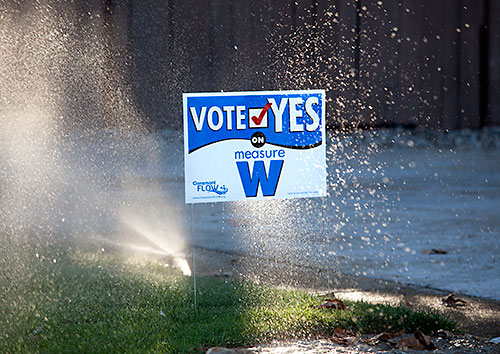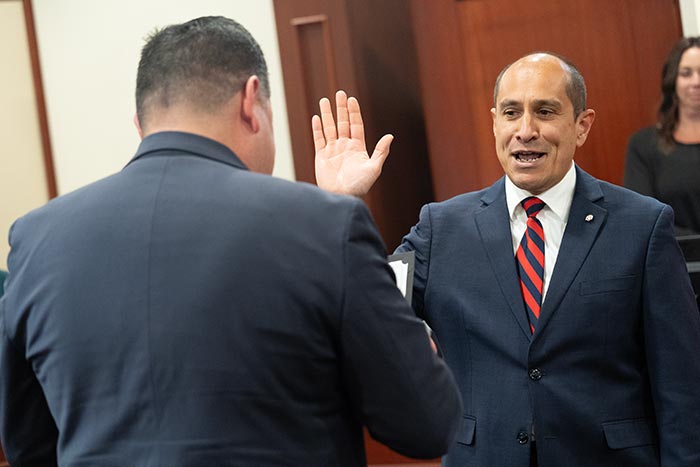As election day nears, Measure W rhetoric intensifies

Yes or no on Measure W? That’s the $135 million-dollar question that Claremont voters will finally have answered on November 4.
A “yes” majority vote will move the city closer to acquiring the water system from Golden State Water Company (GSW), a purchase that the city estimates could cost between $55 million and $135 million and potentially take several years in court.
With only a handful of days remaining before the election, proponents both for and against the measure continue to educate voters on the pros and cons of acquiring a water system that GSW says isn’t for sale.
Yard signs and mailers have circulated throughout the city and water forums have provided the opportunity for representatives to engage residents in debate. Rallies, radio interviews, letters to the editor—the process has been exhausting and it hasn’t always been pretty.
But has it been effective?
A recent poll conducted on the COURIER’s website asked subscribers, “How are you going to vote on Claremont’s Measure W?” Of the 226 respondents, 69 percent voted Yes, 19 percent voted No, and 11 percent remained undecided. If you have not voted, check out our poll in the lower left corner of the COURIER website homepage.
For those still seeking guidance, we offer the following breakdown.
Yes on W
Proponents of Measure W believe gaining control of the water system from Golden State Water Company would allow the city to decrease costs and create its own rate structures. Below are five key points advocated by Claremont Friends of Locally Owned Water (FLOW) and Yes on W.
• There is no substitute for water, which will become increasingly valuable and scarce. We cannot have it under the control of a monopoly that has shown they do not have our best interests at heart, with the possibility of a takeover by a distant multinational company. We owe that to our families and future generations.
• The only certified appraised value of the system is $55 million (and in 2011 Golden State Water sold a larger system in Arizona for $34 million). Claims of much higher costs (such as the $223 million or $101 per month) are scare tactics based on unrealistic assumptions. The $135 million in Measure W is a credit limit not likely to be needed. It’s simply not an expected cost.
• We can afford to pay for the system, and rates would be set locally to reflect actual costs. Claremont residents now pay $8 million more on water bills each year than we would with rates like our neighboring cities. That would support the $135 million in revenue bonds to be used to buy the system without raising rates. The city conservatively estimates rates could be lower early on, if the cost is under $80 million.
• Water revenue bonds are the fair way to finance the purchaser since all water users would pay through their water bills, even tax-exempt institutions. It is not a tax.
• Claremont does not propose to run or manage the water system. That would be contracted out, possibly to the city of La Verne where they have had over a century of experience in running a well-managed system, including provisions for emergencies.
No on W
Opponents to Measure W believe that ratepayers will be taking on an enormous debt without knowing how the system will be run, and that the city and its residents need to get their water usage under control and then work on looking back to buy the water company. Below are five key points advocated by No on W:
• The Feasibility Study is flawed because it assumes there will be an ongoing increase in water consumption. The city should have studied the costs of purchasing the system if water consumption were to be reduced by 20 percent rather than just a model where overhead costs of running the system are reduced.
• To fund a $135 million bond with coverage ratios of 5 percent interest will cost Claremont residents $101.42 per month—that’s $1,217 per year, per family, per home. This is simply the cost to pay off the bond obligation and doesn’t include the price to provide water service or the cost of maintenance.
• There has never been a successful eminent domain takeover of a water company where the cost savings and lower rates residents were promised actually occurred. Proponents of eminent domain takeovers greatly underestimate the value of a water system. Golden State Water is not for sale.
• The city has already spent millions of dollars in its attempt to acquire the water system. If Measure W passes, millions more will be spent in legal fees as the city spends years battling Golden State Water in its bid for eminent domain.
• The city of Claremont charges 5.5 percent utility tax on every component of the bill and it carries forward. No other local municipality that owns a water company charges a utility tax. The city has no plan to fade out the tax with the acquisition of the water system.
One question often asked by No on W proponents is, “Why does the city’s Feasibility Study reflect an increase in water consumption in the upcoming years when the Sustainability Report clearly shows water consumption is expected to decrease?”
City Manager Tony Ramos provides an answer.
“The city’s Financial Feasibility Study assumes an almost 20 percent permanent drop in demand based on Golden State’s actual performance history. This demand drop is due to two factors: the recession and conservation. The model assumes future customer growth of .41 percent a year, an assumption taken directly from Golden State Water’s rate filings. The city’s financial expert’s model assumes customer growth with no increase in consumption per customer. The break-even points remain unchanged, even with consumption levels unchanged. This does not take into account future housing or commercial development in the city,” he explains. “The issue of drop in demand is an issue that exists for Golden State as well. At present, Golden State is guaranteed to a rate of return, which may be recovered through the WRAM in the event customer usage drops. Should the city acquire the water system, decisions on water supply and conservation would be made locally with input from residents.”
Claremont has always been, and will continue to be, a community where all of the facts are presented, residents engage in a spirited debate and the votes are tallied. No doubt about it, there’s a lot to consider as voters head to the polls on Tuesday. Polling stations will open at 7 a.m. and close at 8 p.m. Sample ballots, polling locations and general voter information is available at www.lavote.net.
Results will be posted on the Claremont COURIER’s website on the night of the election.
—Angela Bailey
news@claremont-courier.com










0 Comments